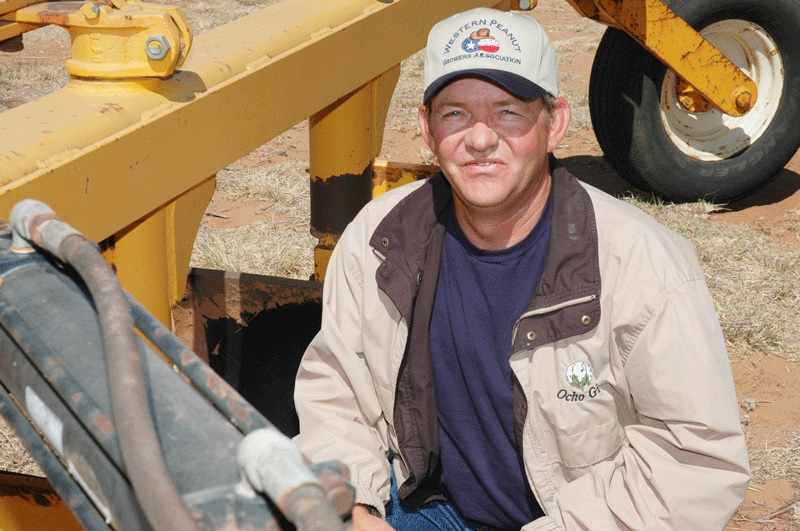
Rotation and moisture management are the two most important factors for growing profitable peanuts in West Texas, says Cornelius Enns, peanut and cotton farmer at Seminole in Gaines County, Texas.
Enns, winner of the 2011 Farm Press Peanut Profitability Award for the Southwest Region, says water is always the limiting factor in his peanut production program. “We have to make every drop of irrigation water count,” he says.
That philosophy helped him average 4,900 pounds per acre for the 2010 crop, including 55 acres of runner peanuts and 60 acres of Virginias. He averaged 5,713 pounds on Virginias and 4,540 pounds per acre on runners.
Like many West Texas farmers, Enns works with a limited water supply. “I have some fields with weak water — 300 gallons for one center pivot circle. Last year I watered as much as I could. It usually takes a week to run the pivot across a half-circle, and I probably watered peanuts 19 or 20 times. I rarely turned the system off, and applied about an inch a week.”
An early July rain helped tremendously, he says. “We got about 5 inches in one week.”
Water management also means pulling back as necessary to help manage pod rot, especially on Virginia-type peanuts. “I can hold off a little,” when conditions favor disease pressure, he says.
He uses wobbler nozzles on pivots, set about 30 inches above the plants. “I like to get peanuts wet from the top to help get pegs in the ground,” he says.
He sticks strictly to a four-year rotation of peanuts and cotton. “Cotton is my main crop, and it is good in rotation with peanuts. The peanut rotation helps the following cotton crop, which picks up a little nitrogen from the peanuts.
Benefits from rotation
“Rotation is probably the reason we have no more disease pressure than we do,” Enns says. “I usually apply some Abound, mostly on Virginia peanuts. One application a year is about average, and that’s enough with a four-year rotation.”
He applies the fungicide in July for pod rot. “I typically don’t use anything on runners — I don’t have enough leaf spot to justify spraying.”
Enns planted the 2010 crop in late April, 55 acres of Flavor Runner 458 and 60 acres of Gregory Virginia peanuts, adding 5 pounds of inoculant per acre. He also put down 52 units of phosphate, 45 units of potassium and 30 to 40 units of nitrogen preplant.
“I applied a total of 150 to 160 units of nitrogen and put 120 of that out through the irrigation system.”
He applies Prowl herbicide, preplant. “If I break and pack, I don’t need much else,” he says. He usually breaks peanut land, packs, goes over the field with a land plane, adds fertilizer and Prowl, runs a springtooth unit to incorporate the herbicide, lists and then plants.
He plants his cotton into wheat stubble, but has not used that method with peanuts.
If he has weed escapes in season, he cultivates or hoes. Four sons — Tommy, Billy, Danny and Freddie, ranging in age from 10 years old to 19 — help with the hoeing. They had to hoe twice last year.
With a late April planting date, Enns typically targets Oct. 5 for digging peanuts. “We’ll dig Virginias about 10 days earlier. I just have a digger; my brother, who lives nearby, combines peanuts for me and I strip his cotton.”
He gets a little premium for Virginia peanuts, but “I lose more when I dig. After we dig Virginias, we can see a lot of nuts on the ground. Runners are a little easier to manage.”
Enns would like to see peanut breeders develop a Virginia-type peanut with vines that hold peanuts a little better. “We might lose as much as 500 pounds of peanuts per acre — just lost on the ground.”
Enns and his wife, Justina, are of German heritage, but grew up in Mexico. “I moved to Seminole because a brother and sister were here,” he says. Justina moved to Seminole when she was 12.
He started working for another farmer when he was 17 and has been farming on his own for eight years. He thinks all four of his sons will eventually want to farm, too. His oldest, Tommy, 19, already works full-time on the farm, and the others work when school is out.
Enns manages production costs closely. “We do as much equipment repair ourselves as we can,” he says. Most of his equipment is well-used, but in good repair
Enns has grown peanuts for the last four or five years, but did not plant any this year. “It was too dry at planting time,” he says “We’ll have fewer peanuts than usual in the area this year because of drought. If we had gotten a rain two weeks before late April, we would have planted peanuts. But with limited water, we’ll use what we have on cotton.”
By early June, Enns and other farmers in the area had received no appreciable rainfall since last July. “We would like to see a good planting rain,” he says. “We’ll irrigate or semi-irrigate all our cotton (790 acres).”
With better planting conditions, he’ll go back to peanuts next year.
About the Author(s)
You May Also Like






